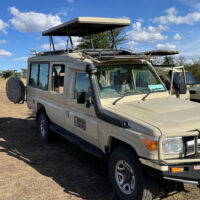The Majesty
of the Serengeti
11.28.2016

Simply to utter the word Serengeti evokes majesty and mystery. One envisions vast green spaces teeming with grazing animals; hordes of beasts crossing muddy rivers, stalked by lions and crocodiles; immense flocks of birds rising as one into the evening sky.
 In fact, the Serengeti is all of these things, and more. The word itself comes from the Maasai language and means “endless plains,” but even that doesn’t cover what this place is, for the 12,000 square miles of this natural wonder include not just plains but also rivers, forests, swamps, grasslands, and savannas.
In fact, the Serengeti is all of these things, and more. The word itself comes from the Maasai language and means “endless plains,” but even that doesn’t cover what this place is, for the 12,000 square miles of this natural wonder include not just plains but also rivers, forests, swamps, grasslands, and savannas.
It is this diversity of habitats, spread across northern Tanzania and southwestern Kenya, that supports the staggering diversity and number of animals on the Serengeti: 70 large mammal and 500 bird species are found there. Blue wildebeests, gazelles, zebras, and buffalos are some of the commonly found large mammals in the region.
 But the picture you may have in your head should not be static, for the diversity of habitat constantly interacts with changes in weather, meaning these vast herds are often on the move, seeking better grazing — and they are stalked by predators who bring not just death but also their own majesty and beauty.
But the picture you may have in your head should not be static, for the diversity of habitat constantly interacts with changes in weather, meaning these vast herds are often on the move, seeking better grazing — and they are stalked by predators who bring not just death but also their own majesty and beauty.
The Serengeti, which contains the Serengeti National Park in Tanzania and several game reserves, is home to the largest terrestrial mammal migration in the world. It is also one of the best places in the world to see prides of lions. And each year this entire show moves in a great circular migration: some 260,000 zebras, 1.7 million wildebeest, 470,000 gazelles, and hundreds of thousand of others.
 Driven by their search for food, and for a safe place to nurture calves, this horde starts in the Ngorongoro Conservation Area of the southern Serengeti in Tanzania. They are here from January to March, and in February the wildebeests alone give birth to some 500,000 calves in just a few weeks.
Driven by their search for food, and for a safe place to nurture calves, this horde starts in the Ngorongoro Conservation Area of the southern Serengeti in Tanzania. They are here from January to March, and in February the wildebeests alone give birth to some 500,000 calves in just a few weeks.
In May, when the rains end, the animals move northwest and in July cross the Grumeti and Mara Rivers — a popular safari moment because it is here that the crocodiles are waiting. They stay in Kenya essentially the rest of the year, then head south when the rains begin; thus the circle completes itself. During this journey, some 250,000 wildebeest will perish.
The question of when to go and see this is tied to what you want to see. January and February are best for the calving (and predators), June and July for the river crossings, August and September for general viewing when the vegetation is thinner and the animals gather around rivers and watering holes.
 The best weather, with little to no rain, is from June to October, the worst is the rainy season from March to May. Outside of those months, rain is generally short and in the afternoon, not something that will interfere with your trip at all. From June to August, it’s recommended to bring warm clothing for early morning game drives.
The best weather, with little to no rain, is from June to October, the worst is the rainy season from March to May. Outside of those months, rain is generally short and in the afternoon, not something that will interfere with your trip at all. From June to August, it’s recommended to bring warm clothing for early morning game drives.
A good outfitter makes all the difference, as will deciding which level of comfort you want, such as a lodge or tents. Whatever other choices you make, the decision to visit the Serenegeti is one that will change your life by showing you life on a scale you currently can only imagine.



